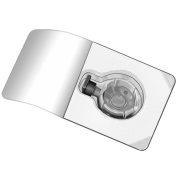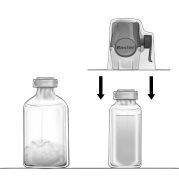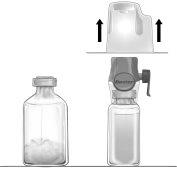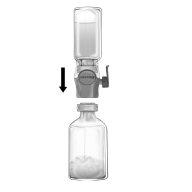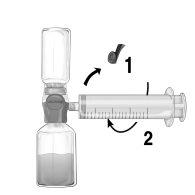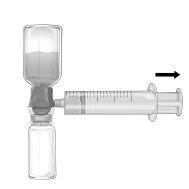
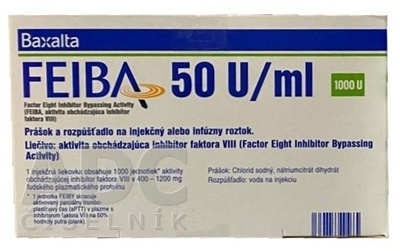
ФЕЙБА 50 МЕ/мл ПОРОШОК И РАСТВОРИТЕЛЬ ДЛЯ ПРИГОТОВЛЕНИЯ РАСТВОРА ДЛЯ ИНФУЗИЙ

Спросите врача о рецепте на ФЕЙБА 50 МЕ/мл ПОРОШОК И РАСТВОРИТЕЛЬ ДЛЯ ПРИГОТОВЛЕНИЯ РАСТВОРА ДЛЯ ИНФУЗИЙ

Инструкция по применению ФЕЙБА 50 МЕ/мл ПОРОШОК И РАСТВОРИТЕЛЬ ДЛЯ ПРИГОТОВЛЕНИЯ РАСТВОРА ДЛЯ ИНФУЗИЙ
Введение
Проспект: информация для пользователя
FEIBA 50 У/мл порошок и растворитель для раствора для инфузии
Антиингибиторный коагулянтный комплекс
Прочитайте внимательно весь проспект перед началом использования этого лекарственного средства, поскольку он содержит важную информацию для вас.
- Сохраните этот проспект, поскольку вам может потребоваться снова прочитать его.
- Если у вас есть какие-либо вопросы, проконсультируйтесь с вашим врачом или фармацевтом.
- Это лекарственное средство было назначено только вам, и не передавайте его другим людям, даже если они имеют те же симптомы, что и вы, поскольку оно может нанести им вред.
- Если вы испытываете побочные эффекты, проконсультируйтесь с вашим врачом или фармацевтом, даже если это побочные эффекты, которые не указаны в этом проспекте. См. раздел 4.
Содержание проспекта
- Что такое FEIBA и для чего он используется
- Что вам нужно знать перед началом использования FEIBA
- Как использовать FEIBA
- Возможные побочные эффекты
- Хранение FEIBA
- Содержание упаковки и дополнительная информация
1. Что такое FEIBA и для чего он используется
FEIBA - это препарат, изготовленный из человеческого плазмы, который позволяет обеспечить гемостаз, даже когда количество конкретных факторов коагуляции снижено или отсутствует.
FEIBA используется для лечения и профилактики кровотечений у пациентов с гемофилией А и ингибитором.
FEIBA используется для лечения кровотечений у пациентов с гемофилией Б и ингибитором.
FEIBA используется для лечения и профилактики кровотечений у не-гемофилических пациентов с приобретенным ингибитором фактора VIII.
Кроме того, FEIBA используется для профилактики во время хирургических вмешательств у пациентов с гемофилией А и ингибитором.
FEIBA можно использовать во всех возрастных группах.
2. Что вам нужно знать перед началом использования FEIBA
Сообщите вашему врачу, если у вас есть известная аллергия.
Сообщите вашему врачу, если вы придерживаетесь диеты с низким содержанием натрия.
Не используйте FEIBA
FEIBA следует использовать только в следующих обстоятельствах, если, например, из-за очень высокого титра ингибиторов не ожидается ответ на лечение с соответствующим концентратом фактора коагуляции:
- если вы аллергичны (гиперчувствительны) к антиингибиторному коагулянтному комплексу или к одному из других компонентов этого лекарственного средства (указанных в разделе 6).
- если существует диссеминированная внутренняя коагуляция (ДВК). (ДВК = коагулопатия потребления, потенциально смертельное состояние, при котором происходит чрезмерная коагуляция крови с выраженным образованием тромбов в кровеносных сосудах. Это приводит к потреблению факторов коагуляции во всем организме)
- в случае инфаркта миокарда, тромбоза и/или эмболии: FEIBA следует использовать только в случаях кровотечения, которые представляют угрозу для жизни.
Предостережения и меры предосторожности
Проконсультируйтесь с вашим врачом перед началом использования FEIBA, поскольку могут возникнуть реакции гиперчувствительности, как и в случае всех продуктов, полученных из плазмы, которые вводятся внутривенно. Чтобы как можно раньше распознать аллергическую реакцию, вы должны знать, что первые потенциальные симптомы гиперчувствительности могут быть:
- эритема (покраснение кожи)
- сыпь на коже
- появление волдырей на коже (уртикария)
- зуд по всему телу
- отек губ и языка
- затруднение дыхания/диспноэ
- давление в груди
- общее недомогание
- головокружение
- падение артериального давления
Другие симптомы реакций гиперчувствительности на продукты, полученные из плазмы, включают летаргию и усталость.
Если вы заметите любой из этих симптомов, вы должны немедленно прекратить введение и связаться с вашим врачом. Симптомы, описанные выше, могут указывать на анафилактический шок. Тяжелые симптомы требуют раннего лечения.
Ваш врач будет использовать FEIBA снова только в случае подозрения на гиперчувствительность к продукту или одному из его компонентов после тщательной оценки ожидаемой пользы и риска повторного введения и/или отсутствия ответа на другое профилактическое или альтернативное лечение.
- Если вы испытываете значительные изменения артериального давления или частоты пульса, затруднения дыхания, кашель или боль в груди, вы должны немедленно прекратить введение и связаться с вашим врачом. Ваш врач начнет соответствующие диагностические и терапевтические меры.
- У пациентов с гемофилией и ингибиторами или с приобретенными ингибиторами коагуляции. Во время лечения FEIBA эти пациенты могут иметь повышенный риск развития кровотечения и повышенный риск тромбоза одновременно.
Во время лечения FEIBA были зарегистрированы тромботические и тромбоэмболические события, включая диссеминированную внутренняя коагуляция (ДВК), венозный тромбоз, легочную эмболию, инфаркт миокарда и инсульт. Вероятно, что одновременное использование с рекомбинантным фактором VIIа увеличивает риск развития тромбоэмболического события. Некоторые из тромбоэмболических событий произошли при лечении высокими дозами FEIBA.
В одном исследовании, проведенном другой компанией для оценки эмицизумаба (лекарственного средства для профилактики кровотечений у пациентов с гемофилией А), некоторые пациенты, которые испытывали межтекущие кровотечения, были лечены FEIBA для контроля кровотечений, и некоторые из этих пациентов развили тромботическую микроангиопатию (ТМА). ТМА - это тяжелое и потенциально опасное для жизни состояние. Когда это состояние возникает, может быть повреждена стенка сосуда, и могут образовываться тромбы в мелких кровеносных сосудах. В некоторых случаях это может привести к повреждению почек и других органов. В случае межтекущих кровотечений во время профилактики эмицизумабом немедленно свяжитесь с вашим гематологом или Центром лечения гемофилии.
Когда вводятся лекарственные средства, полученные из человеческой плазмы или крови, необходимо принять определенные меры для предотвращения передачи инфекций пациентам. Такие меры включают тщательный отбор доноров для исключения тех, кто находится в группе риска быть носителями инфекционных заболеваний, анализ маркеров конкретных инфекций в индивидуальных донорских материалах и в плазменных пулах, а также включение этапов в процессе производства для удаления/инактивации вирусов. Несмотря на это, когда вводятся лекарственные средства, полученные из человеческой крови или плазмы, нельзя полностью исключить возможность передачи инфекционных агентов. Это также относится к возникающим вирусам или вирусам неизвестной природы или другим типам инфекций.
Эти меры считаются эффективными для вирусов с оболочкой, таких как вирус иммунодефицита человека (ВИЧ), вирус гепатита Б и вирус гепатита С, и для не-вirusных вирусов гепатита А. Меры, принимаемые, могут иметь ограниченную ценность для не-вirusных вирусов, таких как парвовирус В19.
Инфекция парвовирусом В19 может быть тяжелой для беременной женщины (инфекция плода) и для людей с ослабленной иммунной системой или для пациентов с некоторыми типами анемии (например, болезнь дрепанцитоз или гемолитическая анемия).
Возможно, что ваш врач порекомендует вам вакцинацию против гепатита А и гепатита Б, если вам регулярно или повторно вводятся продукты, полученные из плазмы, для ингибиторов фактора VIII.
После введения высоких доз FEIBA может произойти временное увеличение передаваемых пассивно антител к поверхностному антигену вируса гепатита Б, что может привести к неправильной интерпретации положительных результатов серологического теста.
FEIBA - это производное плазмы и может содержать вещества, которые реагируют при введении пациентам, вызывая присутствие изогемагглютининов (антител, которые вызывают слипание красных кровяных клеток другого человека). Этот процесс может привести к неправильной интерпретации результатов анализов крови.
Рекомендуется в каждом случае, когда вводится доза FEIBA, записывать название лекарственного средства и номер партии, введенного с целью поддержания учета использованных партий.
Дети
Опыт использования у детей младше 6 лет ограничен; должно быть адаптировано то же дозирование, что и у взрослых, к клиническому состоянию ребенка.
Использование FEIBA с другими лекарственными средствами
Сообщите вашему врачу или фармацевту, если вы используете, недавно использовали или можете использовать любое другое лекарственное средство.
Не были проведены достаточные и хорошо контролируемые исследования использования FEIBA в комбинации или последовательно с рекомбинантным фактором VIIа, антифибринолитиками или эмицизумабом. Когда используются системные антифибринолитики, такие как транексамовая кислота и аминокапроновая кислота, во время лечения FEIBA следует учитывать возможность возникновения тромбоэмболических событий. Следовательно, антифибринолитики не должны использоваться до примерно 6-12 часов после введения FEIBA.
Согласно имеющимся данным in vitro и клиническим наблюдениям, нельзя исключить потенциальное лекарственное взаимодействие при одновременном использовании с рекомбинантным фактором VIIа, которое потенциально может привести к тромбоэмболическому событию.
Сообщите вашему врачу, если вы будете лечены FEIBA после получения эмицизумаба (лекарственного средства для профилактики кровотечений у пациентов с гемофилией А), поскольку необходимо учитывать некоторые конкретные предостережения и меры предосторожности. Ваш врач будет нуждаться в тесном наблюдении за вами.
Как и все продукты, используемые для коагуляции крови, FEIBA не должен смешиваться с другими лекарственными средствами перед введением, поскольку это может повлиять на эффективность и толерантность продукта. Желательно промыть вену изотоническим раствором хлорида натрия до и после введения FEIBA.
Беременность, лактация и фертильность
Если вы беременны или кормите грудью, считаете, что можете быть беременной или планируете стать беременной, проконсультируйтесь с вашим врачом или фармацевтом перед использованием этого лекарственного средства.
Ваш врач решит, можно ли использовать FEIBA во время беременности и лактации. Из-за повышенного риска тромбоза во время беременности FEIBA должен использоваться только под строгим медицинским наблюдением и только если он明ально показан. Для информации о риске инфекции парвовирусом В19 см. раздел предостережения и меры предосторожности.
Вождение и использование машин
Нет никаких признаков того, что FEIBA может повлиять на способность управлять транспортными средствами и работать с машинами.
FEIBA содержит натрий
500 У
Это лекарственное средство содержит примерно 40 мг натрия (основной компонент столовой соли/кухонной соли) в каждом флаконе. Это эквивалентно 2% от максимальной рекомендуемой суточной нормы потребления натрия для взрослого.
1000 У
Это лекарственное средство содержит примерно 80 мг натрия (основной компонент столовой соли/кухонной соли) в каждом флаконе. Это эквивалентно 4% от максимальной рекомендуемой суточной нормы потребления натрия для взрослого.
2500 У
Это лекарственное средство содержит примерно 200 мг натрия (основной компонент столовой соли/кухонной соли) в каждом флаконе. Это эквивалентно 10% от максимальной рекомендуемой суточной нормы потребления натрия для взрослого.
3. Как использовать ФЕИБА
Растворить лиофилизированный порошок ФЕИБА в растворителе, прилагаемом к препарату, и ввести полученный раствор внутривенно.
Следуйте точно инструкциям по введению этого препарата, указанным вашим врачом. В случае сомнений проконсультируйтесь с вашим врачом или фармацевтом.
Ваш врач определит частоту и необходимую для вас дозу, исходя из тяжести нарушения свертываемости крови, местоположения и степени кровотечения, а также вашего клинического состояния и реакции на препарат. Не изменяйте установленную вашим врачом дозировку и не прекращайте введение препарата.
Если вы считаете, что эффект ФЕИБА слишком сильный или слишком слабый, проконсультируйтесь с вашим врачом или фармацевтом.
Нагрейте продукт до комнатной температуры или температуры тела перед введением, если необходимо.
ФЕИБА должен быть растворен непосредственно перед введением. Раствор должен быть использован сразу же (поскольку препарат не содержит консервантов).
Аккуратно встряхните до полного растворения продукта. Убедитесь, что ФЕИБА полностью растворен, поскольку в противном случае через фильтр оборудования пройдет меньше единиц ФЕИБА.
Растворы с мутным видом или содержащие осадки должны быть утилизированы должным образом.
Не повторно используйте открытые контейнеры.
Используйте только воду для инъекций и оборудование для растворения, включенные в упаковку.
Если используются другие устройства, отличные от включенных, убедитесь, что используете фильтр с размером пор не менее 149 мкм.
Не используйте продукт, если система барьерной стерильности или упаковка повреждены или показывают признаки ухудшения.
Не охлаждайте после растворения.
После полного растворения ФЕИБА введение или инфузия должно начаться сразу же и должно быть завершено в течение 3 часов после растворения.
Утилизация неиспользованного препарата и всех материалов, которые вступали в контакт с ним, должна осуществляться в соответствии с местными правилами.
[Для руководства по введению с помощью игл]
Растворение порошка для приготовления раствора для инфузии с помощью игл:
На протяжении всего процедуры следует использовать асептическую технику.
- Нагрейте флакон с растворителем без открытия (воду для инъекций) до комнатной температуры или не более +37 °C, если необходимо.
- Удалите защитные колпачки с флакона, содержащего порошок, и флакона, содержащего растворитель (Рисунок А), и продезинфицируйте резиновые пробки обоих флаконов.
- Поверните и удалите защитный колпачок с одного конца пера для переноса, включенного в комплект, и вставьте перо через резиновую пробку флакона с растворителем (Рисунки Б и В).
- Удалите защитный колпачок с другого конца пера для переноса, избегая прикосновения к нему.
- Переверните флакон с растворителем и вставьте свободный конец пера для переноса через резиновую пробку флакона с порошком (Рисунок Г). Существующий вакуум в этом флаконе засосет растворитель.
- Отделите два флакона, удалив перо для переноса из флакона с порошком (Рисунок Д). Аккуратно встряхните флакон с порошком, чтобы ускорить растворение.
7. После полного растворения порошка вставьте перо для аэрации (Рисунок Е) и исчезнет пена, которая могла образоваться. Удалите перо для аэрации.
Инфузия:
На протяжении всего процедуры следует использовать асептическую технику.
- Поверните и удалите защитный колпачок с одного конца пера для фильтра, включенного в комплект; вытащите и соедините перо с одноразовой стерильной шприцем. Втяните раствор в шприц (Рисунок Ж).
- Отделите перо для фильтра от шприца и введение раствора медленно внутривенно с помощью оборудования для инфузии (или одноразовой иглы).
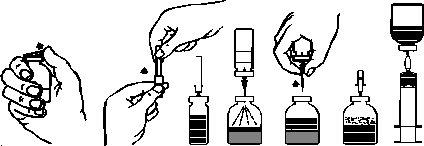
Рисунок А Рисунок Б Рисунок В Рисунок Г Рисунок Д Рисунок Е Рисунок Ж
[Для руководства по введению с помощью BAXJECT II-Hi-Flow]
Растворение порошка для приготовления раствора для инфузии с помощью оборудования BAXJECT II Hi-Flow:
- Нагрейте флакон с растворителем без открытия (воду для инъекций) до комнатной температуры или не более 37°C, если необходимо, например, используя водяную баню в течение нескольких минут.
- Удалите защитные колпачки с флакона, содержащего порошок, и флакона, содержащего растворитель, и продезинфицируйте резиновые пробки обоих флаконов. Поместите флаконы на ровную поверхность.
- Откройте упаковку оборудования BAXJECT II Hi-Flow, удалив защитную пленку, не прикасаясь к содержимому упаковки (Рисунок а). Не вынимайте оборудование из упаковки.
- Переверните упаковку и вставьте прозрачный пластиковый наконечник через резиновую пробку флакона с растворителем (Рисунок б). Теперь выньте оборудование BAXJECT II Hi-Flow из упаковки (Рисунок в). Не удаляйте синий защитный колпачок с оборудования BAXJECT II Hi-Flow.
- С оборудованием BAXJECT II Hi-Flow, соединенным с флаконом с растворителем, переверните систему так, чтобы флакон с растворителем был в верхней части оборудования. Вставьте фиолетовый пластиковый наконечник оборудования BAXJECT II Hi-Flow через пробку флакона с ФЕИБА. Вакуум заставит растворитель проникнуть во флакон с ФЕИБА (Рисунок г).
- Аккуратно встряхните всю систему, не тряся, до полного растворения порошка. Убедитесь, что ФЕИБА полностью растворен, поскольку в противном случае активное вещество может остаться в фильтре оборудования.
Рисунок а | Рисунок б | Рисунок в |
|
|
|
Инфузия
Используйте асептическую технику на протяжении всего процедуры!
- Удалите синий защитный колпачок с оборудования BAXJECT II Hi-Flow. Соедините шприц с оборудованием BAXJECT II Hi-Flow. НЕ ВВОДИТЕ ВОЗДУХ В ШПРИЦ. (Рисунок д). Рекомендуется использовать шприц с системой Luer Lock, чтобы обеспечить надежное соединение между шприцем и оборудованием BAXJECT II Hi-Flow (поверните шприц по часовой стрелке до упора).
- Переверните систему так, чтобы растворенный продукт был в верхней части. Введите растворенный продукт в шприц, медленно вытягивая поршень и обеспечивая надежное соединение между устройством BAXJECT II Hi-Flow и шприцем на протяжении всего процесса (Рисунок е).
- Отсоедините шприц.
- Если образуется пена внутри шприца, подождите, пока пена не уменьшится. Введите раствор внутривенно с помощью оборудования для инфузии (или одноразовой иглы).
Рисунок г | Рисунок д | Рисунок е |
|
|
|
Не превышайте скорость инфузии 2 единиц ФЕИБА/кг в минуту.
Если вы примете больше ФЕИБА, чем необходимо
Сообщите об этом вашему врачу немедленно. Передозировка ФЕИБА может увеличить риск побочных эффектов, таких как тромбоэмболия (образование кровяного сгустка с покраснением в кровеносных сосудах), диссеминированная внутрисосудистая коагуляция (ДВК) или инфаркт миокарда. Некоторые тромбоэмболические события были зарегистрированы при дозах выше 200 единиц/кг/день или у пациентов с другими факторами риска тромбоэмболических событий.
Если出现 признаки или симптомы тромбоэмболического события, инфузию необходимо немедленно прекратить и принять необходимые диагностические и терапевтические меры.
4. Возможные побочные эффекты
Как и все лекарства, это лекарство может вызывать побочные эффекты, хотя не все люди испытывают их.
Частые побочные эффекты(могут затронуть до 1 из 10 пациентов)
Гиперчувствительность, головная боль, головокружение, гипотония, кожная сыпь, положительные антитела к поверхности вируса гепатита Б.
Побочные эффекты с неизвестной частотой(не могут быть оценены на основе доступных данных)
Расстройства крови и лимфатической системы:диссеминированная внутрисосудистая коагуляция (ДВК), увеличение титра ингибитора
Расстройства иммунной системы:анафилактические реакции, кожная сыпь по всему телу (уртикария)
Расстройства нервной системы:онемение конечностей (гипоэстезия), измененная или уменьшенная чувствительность (парестезия), инсульт (тромботический или эмболический), сонливость, изменение вкуса (дисгевзия).
Расстройства сердечно-сосудистой системы:инфаркт миокарда (инфаркт), сердцебиение (тахикардия)
Расстройства сосудов:образование кровяных сгустков с покраснением в кровеносных сосудах (тромбоэмболические события, венозная и артериальная тромбоз), повышение артериального давления (гипертония), краснота.
Расстройства дыхательной системы, грудной клетки и средостения:эмболия легочной артерии (легочная эмболия), обструкция дыхательных путей (бронхоспазм), свист в груди, кашель, затруднение дыхания (диспноэ).
Расстройства желудочно-кишечной системы:рвота, диарея, боль в животе, чувство болезни (тошнота)
Расстройства кожи и подкожной ткани:онемение лица, отек лица, языка и губ (ангиоэдема), кожная сыпь по всему телу (уртикария), зуд (прурит).
Общие расстройства и изменения в месте введения:боль в месте введения, общее недомогание, чувство жара, озноб, лихорадка, боль в груди, дискомфорт в груди.
Дополнительные исследования:снижение артериального давления, повышение уровня Д-димера фибрина в крови.
Быстрая внутривенная инфузия может вызвать острую боль и онемение лица и конечностей, а также снижение артериального давления.
Были зарегистрированы случаи инфаркта миокарда после введения доз выше максимальной суточной дозы и/или при длительном введении и/или при наличии факторов риска тромбоэмболических событий.
Сообщение о побочных эффектах
Если вы испытываете любой побочный эффект, проконсультируйтесь с вашим врачом, даже если это возможные побочные эффекты, не указанные в этом руководстве. Вы также можете сообщить об этом напрямую через Испанскую систему фармаковигиланса лекарственных средств для человека: www.notificaram.es
Сообщая о побочных эффектах, вы можете внести свой вклад в предоставление более полной информации о безопасности этого лекарства.
5. Хранение ФЕИБА
Храните это лекарство в недоступном для детей месте.
Не храните при температуре выше 25 °C. Не замораживайте.
Храните в оригинальной упаковке, чтобы защитить от света.
Не используйте это лекарство после даты истечения срока годности, указанной на этикетке и упаковке. Дата истечения срока годности - последний день месяца, указанного.
Лекарства не должны выбрасываться в канализацию или мусор. Спросите у вашего фармацевта, как утилизировать упаковку и лекарства, которые вам больше не нужны. Таким образом, вы поможете защитить окружающую среду.
6. Содержание упаковки и дополнительная информация
Состав ФЕИБА
Порошок
- Активное вещество в одном флаконе представляет собой антиингибиторный коагулянтный комплекс.
- 1 мл содержит 50 ЕД антиингибиторного коагулянтного комплекса.
- ФЕИБА 50 ЕД/мл выпускается в трех формах:
- Форма выпуска 500 ЕД ФЕИБА содержит 500 ЕД (единиц) антиингибиторного коагулянтного комплекса в 200 – 600 мг человеческого плазменного белка.
- Форма выпуска 1000 ЕД ФЕИБА содержит 1000 ЕД (единиц) антиингибиторного коагулянтного комплекса в 400 – 1200 мг человеческого плазменного белка.
- Форма выпуска 2500 ЕД ФЕИБА содержит 2500 ЕД (единиц) антиингибиторного коагулянтного комплекса в 1000 – 3000 мг человеческого плазменного белка.
- ФЕИБА также содержит факторы II, IX и X, в основном неактивированные, а также активированный фактор VII. Антиген фактора VIII свертывания крови (F VIII C:Ag), а также факторы системы калликреин-кинин присутствуют только в следовых количествах.
- Другие компоненты - хлорид натрия и цитрат натрия.
Растворитель
- Вода для инъекций
Внешний вид продукта и содержание упаковки
Продукт выпускается в виде лиофилизированного или рассыпного порошка белого или бледно-зеленого цвета. Реконституированный раствор имеет pH между 6,8 и 7,6.
Порошок и растворитель поставляются в стеклянных флаконах, закрытых резиновыми пробками.
Презентация:1 х 500 ЕД
1 х 1000 ЕД
1 х 2500 ЕД
Возможно, что только некоторые размеры упаковок будут продаваться.
[Для листка-вкладыша для введения с помощью игл]
Содержание упаковки:
- 1 флакон с 500 ЕД / 1000 ЕД ФЕИБА - порошок для раствора для инфузии
- 1 флакон с 10 мл / 20 мл воды для инъекций
- 1 одноразовая шприц
- 1 одноразовая игла
- 1 бабочка-игла
- 1 фильтр-игла
- 1 игла для переливания
- 1 игла для аэрации
[Для листка-вкладыша для введения с помощью BAXJECT II-Hi-Flow]
Содержание упаковки:
- 1 флакон с 500 ЕД/1000 ЕД/2500 ЕД ФЕИБА - порошок для раствора для инфузии
- 1 флакон с 10 мл/20 мл/50 мл воды для инъекций
- 1 комплект для реконституции BAXJECT II Hi-Flow
- 1 одноразовая шприц
- 1 одноразовая игла
- 1 бабочка-игла
Владелец разрешения на маркетинг и производитель
Владелец разрешения на маркетинг
Baxalta Innovations GmbH
Industriestrasse, 67
1221 Вена, Австрия
Производитель
Takeda Manufacturing Austria AG Industriestrasse, 67
1221 Вена, Австрия
Местный представитель владельца
Takeda Farmacéutica España S.A.
Калле Альбасете, 5, 9-й этаж,
Эдифисио Лос Кубос
28027 Мадрид
Испания
Тел: +34 91 790 42 22
Этот препарат разрешен к применению в государствах-членах Европейского экономического пространства под следующими названиями:
Австрия:
FEIBA 50 ЕД/мл Порошок и растворитель для приготовления раствора для инфузии
Хорватия:
FEIBA 50 ЕД/мл Порошок и растворитель для приготовления раствора для инфузии
Кипр:
FEIBA 50 ЕД/мл Πорошок и растворитель для приготовления раствора для инфузии
Чехия: FEIBA NF
Дания:
Feiba
Эстония:
FEIBA
Финляндия:
Feiba
Германия: FEIBA 500 ЕД, FEIBA 1000 ЕД, FEIBA 2500 ЕД
Греция:
FEIBA 50 ЕД/мл Πорошок и растворитель для приготовления раствора для инфузии
Ирландия:
FEIBA 50 ЕД/мл Порошок и растворитель для приготовления раствора для инфузии
Латвия: Feiba 50 ЕД/мл Порошок и растворитель для приготовления раствора для инфузии
Литва: Feiba 50 ЕД/мл Порошок и растворитель для приготовления раствора для инфузии
Мальта: FEIBA 50 ЕД/мл Порошок и растворитель для приготовления раствора для инфузии
Нидерланды: FEIBA 50 ЕД/мл Порошок и растворитель для приготовления раствора для инфузии
Норвегия:
Feiba
Румыния:
FEIBA 50 ЕД/мл Порошок и растворитель для приготовления раствора для инфузии
Словакия: FEIBA 50 ЕД/мл Порошок и растворитель для приготовления раствора для инфузии
Словения:
FEIBA 50 ЕД/мл Порошок и растворитель для приготовления раствора для инфузии
Испания:
FEIBA 50 ЕД/мл Порошок и растворитель для приготовления раствора для инфузии
Швеция:
Feiba 50 ЕД/мл Порошок и растворитель для приготовления раствора для инфузии
Дата последнего пересмотра этого листка-вкладыша:август 2024
Подробная и актуальная информация о этом препарате доступна на сайте Агентства по лекарственным средствам и медицинским изделиям Испании (AEMPS) http://www.aemps.gob.es/
---------------------------------------------------------------------------------------------------------------------
Эта информация предназначена только для медицинских специалистов:
Лечение должно быть начато и контролироваться под наблюдением врача с опытом лечения коагулопатий.
Дозировка
Доза и продолжительность терапии зависят от тяжести нарушения гемостаза, местоположения и тяжести кровотечения, а также от общего состояния пациента.
Доза и частота введения всегда должны устанавливаться в зависимости от клинической эффективности в каждом случае.
Как общее руководство, рекомендуются дозы 50–100 ЕД/кг ФЕИБА; не следует превышать единовременную дозу 100 ЕД/кг или максимальную суточную дозу 200 ЕД/кг, если только тяжесть кровотечения не требует и не оправдывает использование более высоких доз.
Из-за специфических факторов пациентов реакция на обходной агент может варьироваться, и в ситуации с определенным кровотечением пациенты с недостаточной реакцией на один агент могут реагировать на другой агент. В случае недостаточной реакции на обходной агент следует рассмотреть возможность использования другого агента.
Педиатрическое население
Опыт использования у детей младше 6 лет ограничен; следует использовать ту же дозировку, что и для взрослых, с учетом клинического состояния ребенка.
- Спонтанное кровотечение
Кровотечения в суставах, мышцах и мягких тканях
Для легких и умеренных кровотечений рекомендуется доза 50–75 ЕД/кг каждые 12 часов. Лечение должно продолжаться до тех пор, пока не появятся явные признаки клинического улучшения, такие как уменьшение боли, снижение отека или увеличение подвижности сустава.
Для тяжелых кровотечений в мышцах и мягких тканях, например, ретроперитонеального кровотечения, рекомендуется доза 100 ЕД/кг каждые 12 часов.
Кровотечения в слизистых оболочках
Рекомендуется доза 50 ЕД/кг каждые 6 часов под строгим наблюдением за пациентом (визуальный контроль кровотечения, повторный гематокрит). Если кровотечение не останавливается, можно увеличить дозу до 100 ЕД/кг; однако не следует превышать дозу 200 ЕД/кг.
Другие тяжелые кровотечения
При тяжелом кровотечении, таком как кровотечение в центральной нервной системе, рекомендуется доза 100 ЕД/кг каждые 12 часов. В отдельных случаях можно вводить ФЕИБА каждые 6 часов, пока не появятся явные признаки клинического улучшения (не следует превышать максимальную суточную дозу 200 ЕД/кг).
- Хирургия
При хирургических вмешательствах можно вводить начальную дозу 100 ЕД/кг перед операцией, и через 6–12 часов после операции можно ввести еще одну дозу 50–100 ЕД/кг. В качестве поддерживающей дозы после операции можно вводить 50–100 ЕД/кг каждые 6–12 часов; доза, интервалы дозирования и продолжительность лечения пери- и постоперационного периода зависят от хирургического вмешательства, общего состояния пациента и клинической эффективности в каждом случае (не следует превышать максимальную суточную дозу 200 ЕД/кг).
- Профилактика у пациентов с гемофилией А и ингибитором
- Профилактика кровотечений у пациентов с высоким титром ингибитора и частыми кровотечениями после неудачной попытки индукции иммунотолерантности (ИТ) или когда такая индукция не считается возможной:
Рекомендуется доза 70–100 ЕД/кг в чередующиеся дни. Если необходимо, дозу можно увеличить до 100 ЕД/кг в день или постепенно уменьшить.
- Профилактика кровотечений у пациентов с высоким титром ингибитора во время индукции иммунотолерантности (ИТ):
Можно вводить ФЕИБА в комбинации с фактором VIII в интервале доз 50–100 ЕД/кг, дважды в день, пока титр ингибитора фактора VIII не снизится до <2 ЕД.*< p>
* 1 единица Бетесды определяется как количество антител, которое ингибирует 50% активности фактора VIII в плазме, инкубированной (2 часа при 37 °C).
- Использование ФЕИБА у особых групп пациентов
ФЕИБА также использовался в комбинации с концентратом фактора VIII в качестве длительного лечения для полного и постоянного удаления ингибитора фактора VIII.
Мониторинг
В случае недостаточной реакции на лечение препаратом рекомендуется провести подсчет тромбоцитов, поскольку для эффективности лечения препаратом необходимое количество функционально целых тромбоцитов.
Из-за сложного механизма действия нет прямого мониторинга активных начал. Тесты на свертываемость крови, такие как время свертываемости крови (ТСК), тромбоэластограмма (ТЭГ, значение r) и время активированного частичного тромбопластинового времени (апТВ), обычно показывают только незначительное укорочение, которое не обязательно коррелирует с клиническим улучшением. По этим причинам полезность этих тестов для мониторинга лечения ФЕИБА очень ограничена.
Способ введения
ФЕИБА должен вводиться медленно внутривенно. Не следует превышать скорость инфузии 2 ЕД/кг в минуту.
ФЕИБА должен быть реконституирован непосредственно перед введением. Раствор должен быть использован немедленно (поскольку приготовление не содержит консервантов). Не используйте мутные растворы или растворы, содержащие осадки. Утилизация неиспользованного препарата и всех материалов, которые были в контакте с ним, должна осуществляться в соответствии с местными правилами.
Мониторинг терапии
Не следует превышать единовременные дозы 100 ЕД/кг или суточные дозы 200 ЕД/кг. Пациенты, получающие более 100 ЕД/кг, должны быть под наблюдением для развития острого коронарного синдрома и/или ишемии, а также для симптомов тромботических или тромбоэмболических событий. Для остановки кровотечения высокие дозы ФЕИБА должны вводиться только в течение времени, строго необходимого для этого.
Если появляются клинически значимые изменения артериального давления или частоты сердечных сокращений, затруднение дыхания, кашель или боль в груди, инфузию следует немедленно прекратить, и необходимо принять необходимые диагностические и терапевтические меры. Аналитические параметры, характерные для острого коронарного синдрома, - снижение фибриногена, снижение количества тромбоцитов и/или наличие продуктов распада фибриногена (ПРФ). Другие параметры для развития острого коронарного синдрома - значительное удлинение времени тромбина, времени протромбина или времени активированного частичного тромбопластинового времени (апТВ). У пациентов с гемофилией и ингибитором или с приобретенными ингибиторами факторов VIII, IX и/или XI апТВ удлинено из-за основного заболевания.
Введение ФЕИБА у пациентов с ингибитором может привести к первоначальному "анамнестическому" увеличению уровня ингибитора. Во время продолжительного введения ФЕИБА уровень ингибитора может снизиться с течением времени. И клинические данные, и опубликованные данные свидетельствуют о том, что эффективность ФЕИБА не снижается.
Пациенты с гемофилией и ингибитором или с приобретенными ингибиторами факторов свертывания крови, получающие лечение ФЕИБА, могут быть более склонны к кровотечению, а также могут иметь повышенный риск тромбоза.
Лабораторные тесты и клиническая эффективность
Витро-тесты для контроля эффективности, такие как апТВ, время свертываемости крови (ТСК) и тромбоэластограмма (ТЭГ), не обязательно коррелируют с клиническим улучшением. По этой причине не следует стремиться к нормализации этих значений путем увеличения дозы ФЕИБА, и даже это категорически не рекомендуется из-за возможного риска развития острого коронарного синдрома при передозировке.
Важность подсчета тромбоцитов
В случае недостаточной реакции на лечение ФЕИБА рекомендуется провести подсчет тромбоцитов, поскольку для эффективности лечения ФЕИБА необходимое количество функционально целых тромбоцитов.
Лечение пациентов с гемофилией Б и ингибитором
Опыт использования у пациентов с гемофилией Б и ингибитором фактора IX ограничен из-за редкости заболевания. Пять пациентов с гемофилией Б и ингибитором были лечены ФЕИБА в ходе клинических испытаний, либо по требованию, либо в профилактических целях, либо во время хирургических вмешательств:
В одном клиническом исследовании, проводившемся в открытом, рандомизированном и параллельном режиме у пациентов с гемофилией А или Б с постоянно повышенным титром ингибитора (090701, PROOF), 36 пациентов были рандомизированы для получения профилактического или по требованию лечения в течение 12 месяцев ± 14 дней. 17 пациентов из группы профилактического лечения получали 85 ± 15 ЕД/кг ФЕИБА, вводимого в чередующиеся дни, и 19 пациентов из группы лечения по требованию получали индивидуальное лечение, определяемое врачом. Два пациента с гемофилией Б и ингибитором получали лечение по требованию, и один пациент с гемофилией Б получал профилактическое лечение.
Медиана годовой частоты кровотечений (ГЧК) для всех типов эпизодов кровотечения у пациентов группы профилактического лечения (медиана ГЧК = 7,9) была ниже, чем у пациентов группы лечения по требованию (медиана ГЧК = 28,7), что соответствует снижению медианы ГЧК на 72,5% между группами лечения.
В другом завершенном исследовании, проводившемся в режиме наблюдения за безопасностью или неинтервенционном режиме использования ФЕИБА в периоперационном периоде (PASS-INT-003, SURF), было проведено в общей сложности 34 хирургических вмешательства у 23 пациентов. Большинство пациентов (18) страдали конгенитальной гемофилией А с ингибитором, двое были пациентами с гемофилией Б и ингибитором, и трое были пациентами с приобретенной гемофилией А и ингибитором. Время экспозиции ФЕИБА варьировалось от 1 до 28 дней, со средним значением 9 дней и медианой 8 дней. Средняя накопленная доза составила 88 347 ЕД, а медиана дозы - 59 000 ЕД. У пациентов с гемофилией Б и ингибитором максимальная продолжительность экспозиции ФЕИБА составила 21 день, а максимальная введенная доза - 7324 ЕД.
Также в литературе описано 48 пациентов, у которых ФЕИБА использовался для лечения и профилактики эпизодов кровотечения у пациентов с гемофилией Б и ингибитором фактора IX (34 пациента с гемофилией Б и ингибитором получали лечение по требованию, 6 пациентов с гемофилией Б и ингибитором получали профилактическое лечение, и 8 пациентов с гемофилией Б и ингибитором получали лечение во время хирургических вмешательств).
Кроме того, имеются отдельные сообщения об использовании ФЕИБА для лечения пациентов с приобретенными ингибиторами факторов IX, X, XI и XIII.
В редких случаях ФЕИБА также использовался у пациентов с ингибитором фактора фон Виллебранда.
- Страна регистрации
- Активное вещество
- Требуется рецептДа
- Производитель
- Информация носит справочный характер и не является медицинской рекомендацией. Перед приемом любых препаратов проконсультируйтесь с врачом. Oladoctor не несет ответственности за медицинские решения, принятые на основе этого контента.
- Аналоги ФЕЙБА 50 МЕ/мл ПОРОШОК И РАСТВОРИТЕЛЬ ДЛЯ ПРИГОТОВЛЕНИЯ РАСТВОРА ДЛЯ ИНФУЗИЙФорма выпуска: ИНЪЕКЦИОННЫЙ РАСТВОР ДЛЯ ИНФУЗИЙ, 100 ЕД/млАктивное вещество: factor VIII inhibitor bypassing activityПроизводитель: Baxalta Innovations GmbhТребуется рецептФорма выпуска: ИНЪЕКЦИОННЫЙ РАСТВОР, 1000 МЕАктивное вещество: фактор свертывания крови VIIIПроизводитель: Takeda Manufacturing Austria AgТребуется рецептФорма выпуска: ИНЪЕКЦИОННЫЙ РАСТВОР, 1500 МЕАктивное вещество: фактор свертывания крови VIIIПроизводитель: Takeda Manufacturing Austria AgТребуется рецепт
Аналоги ФЕЙБА 50 МЕ/мл ПОРОШОК И РАСТВОРИТЕЛЬ ДЛЯ ПРИГОТОВЛЕНИЯ РАСТВОРА ДЛЯ ИНФУЗИЙ в других странах
Лучшие аналоги с тем же действующим веществом и терапевтическим эффектом.
Аналог ФЕЙБА 50 МЕ/мл ПОРОШОК И РАСТВОРИТЕЛЬ ДЛЯ ПРИГОТОВЛЕНИЯ РАСТВОРА ДЛЯ ИНФУЗИЙ в Польша
Врачи онлайн по ФЕЙБА 50 МЕ/мл ПОРОШОК И РАСТВОРИТЕЛЬ ДЛЯ ПРИГОТОВЛЕНИЯ РАСТВОРА ДЛЯ ИНФУЗИЙ
Консультация по дозировке, побочным эффектам, взаимодействиям, противопоказаниям и продлению рецепта на ФЕЙБА 50 МЕ/мл ПОРОШОК И РАСТВОРИТЕЛЬ ДЛЯ ПРИГОТОВЛЕНИЯ РАСТВОРА ДЛЯ ИНФУЗИЙ – по решению врача и с учетом местных правил.




